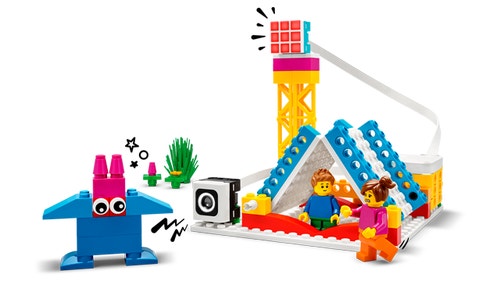Animal Alarm
Leo does not want to miss any of the animals walking past his campsite while he is asleep. How can his animal alarm help him?

Prepare
- Review the Animal Alarm lesson in the LEGO® Education SPIKE™ App.
- If you feel that it would be beneficial, pre-teach these related vocabulary words: alarm, cause, Colour Sensor, creature, effect and react.
- Consider the abilities and backgrounds of all your pupils. Differentiate the lesson to make it accessible to everyone. Please refer to the Differentiation section below for suggestions on how to do this.
- If time permits, plan and facilitate the language arts extension. Please refer to the Extension section below for further information.
Engage
(Whole Class, 5 Minutes)
- Facilitate a quick discussion about cause and effect.
- Talk with your pupils about what happens when an alarm (e.g. fire alarm, alarm clock, mobile phone alert) goes off.
- Ask questions like these: What would happen if you heard an alarm going off? What would you think is happening?
- Introduce your pupils to the story’s main characters and the first challenge: switching on the animal alarm.
- Distribute a brick set and a device to each group.
Explore
(Small Groups, 30 Minutes)
- Have your pupils use the LEGO® Education SPIKE™ App to guide them through their first challenge:
- Make and try the program that switches on the alarm when a blue creature walks past the Colour Sensor.
- Have your pupils iterate and test their models to complete the next challenge in the app:
- Change the program to react when a red creature walks past.
- You can find help with coding in the Tips section below.
Explain
(Whole Class, 5 Minutes)
- Gather your pupils together to reflect on their completed challenges.
- Ask questions like these: What happened when a blue creature walked past the alarm? How did you change the alarm to react when a red creature walked past?
Elaborate
(Whole Class, 5 Minutes)
- Prompt your pupils to discuss and reflect on cause and effect.
- Ask questions like these: Where do you see cause and effect happening around you? Why is it important to predict cause and effect?
- Have your pupils tidy up their workstations.
Evaluate
(Ongoing Throughout the Lesson)
- Ask guiding questions to encourage your pupils to ‘think aloud’ and explain their thought processes and reasoning in the decisions they have made while building and programming their models.
Observation Checklist
- Measure your pupils’ proficiency in identifying cause and effect.
- Establish a scale that suits your needs. For example:
- Requires additional support
- Can work independently
- Can teach others
Self-Assessment
Have each pupil choose the brick that they feel best represents their performance.
- Yellow: I think that I can identify cause and effect.
- Blue: I can identify cause and effect.
- Green: I can identify cause and effect, and I can also help a friend to do it.
Peer Feedback
- In their small groups, have your pupils discuss their experiences working together.
- Encourage them to use statements like these:
- I liked it when you…
- I would like to hear more about how you…
Tips
Coding Tips
- After your pupils have completed their first challenge, they will be provided with a map.
- Using the map, your pupils can experiment with the available Coding Blocks to modify their programs to follow the route for the trip.




Differentiation
Simplify this lesson by:
- Reading the Animal Alarm story and instructions from the LEGO® Education SPIKE™ App aloud to your pupils
- Shortening the lesson to include only the first challenge
Increase the difficulty by:
- Changing the alarm to react differently when a yellow or green creature walks past the Colour Sensor
- Clicking Show Full Palette in the app to utilise more Coding Blocks
Extension
- Have your pupils research and write about various nocturnal animals that could walk past Leo’s campsite.
If facilitated, this will extend beyond the 45-minute lesson.
Language Arts: ACELA1430
Understand that texts can take many forms, can be very short (for example an exit sign) or quite long (for example an information book or a film) and that stories and informative texts have different purposes.
Teacher Support
The pupils will:
- Identify cause and effect
- Develop a program to solve a problem
- Practise helping a story character
- Participate in collaborative conversations
(one for every two pupils)
- LEGO® Education SPIKE™ Essential Set
- Device with the LEGO® Education SPIKE™ App installed
Design and Technologies
ACTDEK004
Explore the characteristics and properties of materials and components that are used to produce designed solutions.
Digital Technologies
ACTDIP005
Explore how people safely use common information systems to meet information, communication, and recreation needs.
English Language
ACELA1447
Understand that the purposes texts serve shape their structure in predictable ways.




